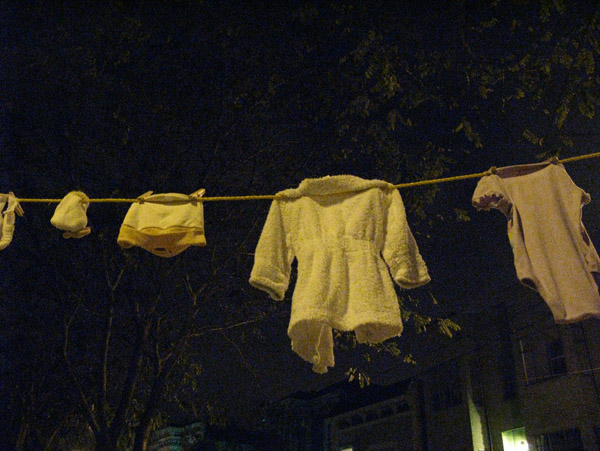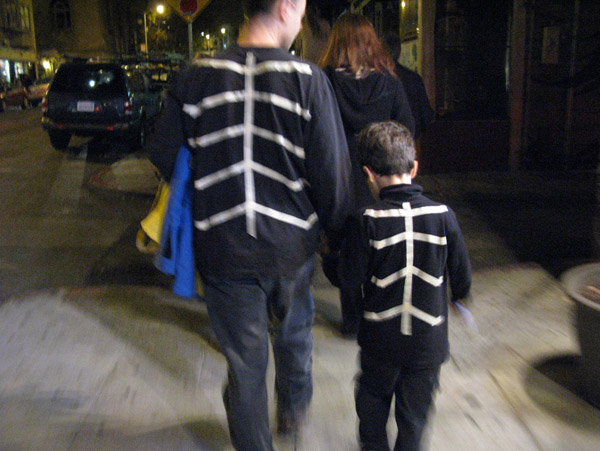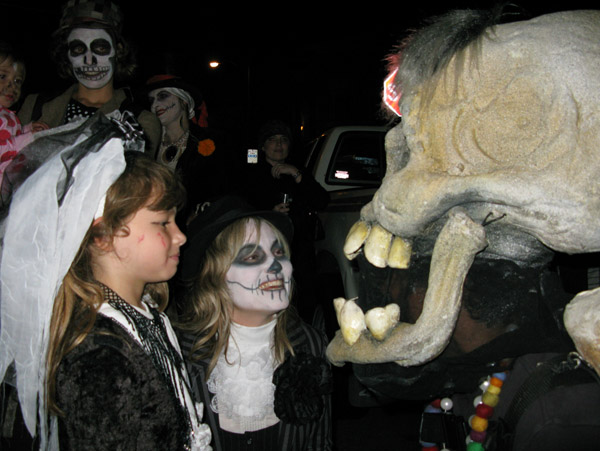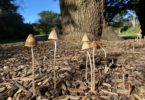“Let’s have fun at a death party” is probably not the most commonly uttered combination of words in the English language. There’s something a bit too irreverent and dangerously inappropriate about the image, like a friendly slap on fearsome Lord Voldemort’s back, affectionately calling He-Who-Must-Not-Be-Named “Voldy.” Death and celebration don’t usually get to tango in our collective psyche, and yet, every year on November 2nd, right down the street from my house, a throng of hip-shaking, candle-carrying and guitar-strumming neighbors do just that: Celebrate the dead.
 Dia de los Muertos, or Day of the Dead, is an ancient practice blending pre-hispanic Aztec philosophy and medieval European ritual, celebrated throughout Mexican culture and increasingly among non-Latinos in the US. I can attest to the latter, as the Dia de los Muertos procession through my neighborhood in San Francisco has grown ever more popular over the last decade or so. It’s my favorite holiday, not only because it brings out some of the most artistic and colorful forms of human expression I’ve ever seen, but because for one day we all get to hang out with each other’s ancestors as if they lived right around the corner. Turns out they actually do.
Dia de los Muertos, or Day of the Dead, is an ancient practice blending pre-hispanic Aztec philosophy and medieval European ritual, celebrated throughout Mexican culture and increasingly among non-Latinos in the US. I can attest to the latter, as the Dia de los Muertos procession through my neighborhood in San Francisco has grown ever more popular over the last decade or so. It’s my favorite holiday, not only because it brings out some of the most artistic and colorful forms of human expression I’ve ever seen, but because for one day we all get to hang out with each other’s ancestors as if they lived right around the corner. Turns out they actually do.
Just like the other 364 days of the year that we’ve selfishly reserved to honor every little detail of life and the living, the traditions and activities surrounding the Day of the Dead vary between regions and from town to town. In The Mission, our deceased are often vegetarian, ride their bikes, and have been known to toke on the occasional reefer. In this sea of skeletons there’s tons of music, drumming, and dancing, giving quite literal meaning to the shaking of bones. The ancestors are showered with generous helpings of fresh tamales, sugar skulls, and Negra Modelos, and it’s not unusual that there’s enough to go around for us mortals. Death never felt so full of life.
You sense the loss. You feel the pain. You wonder why.
 Of course, this fiesta is far from being a boisterous bash, and upon entering Garfield Park, host to an astonishing array of motley and painstakingly arranged altars, you immediately understand why. The ink on many of the photos of departed loved ones has barely dried, and the tender faces on some of them belong to slain teenagers and victims of childhood cancer. A couple of years ago, the baby clothes hanging on a line between two trees nearly broke my heart. There’s a solemn feel in the air, a dignified volume of voices, a quiet overtone to the drums, a respect for individual space in the sea of humanity. You sense the loss. You feel the pain. You wonder why.
Of course, this fiesta is far from being a boisterous bash, and upon entering Garfield Park, host to an astonishing array of motley and painstakingly arranged altars, you immediately understand why. The ink on many of the photos of departed loved ones has barely dried, and the tender faces on some of them belong to slain teenagers and victims of childhood cancer. A couple of years ago, the baby clothes hanging on a line between two trees nearly broke my heart. There’s a solemn feel in the air, a dignified volume of voices, a quiet overtone to the drums, a respect for individual space in the sea of humanity. You sense the loss. You feel the pain. You wonder why.
And that’s the point.
It’s probably fair to say that death is one of the most taboo subjects in the US and most of the western world, with cultural values and entire industries designed to keep us from having to deal with our own mortality. It’s almost as if we’re in the closet — or at least in a perpetual state of “don’t ask, don’t tell” — about the most natural event on earth and the one thing we all have in common, not only with each other, but with all living creatures on this planet: the fact that we’re all going to die.
 Sure, there’s our innate survival instinct, a primordial and healthy mechanism without which no life would exist at all. However, considering that we humans seem to be the only species on earth with the built-in feature of self-reflection and the consciousness of our own impermanence, it’s quite puzzling that we let such a special gift be drowned out by denial, fear, and even shame.
Sure, there’s our innate survival instinct, a primordial and healthy mechanism without which no life would exist at all. However, considering that we humans seem to be the only species on earth with the built-in feature of self-reflection and the consciousness of our own impermanence, it’s quite puzzling that we let such a special gift be drowned out by denial, fear, and even shame.
We’re just funny that way — we haggle over which religion has the trademark on the meaning of life, spend fortunes on churches, meditation retreats, and spiritual self-help books, and concoct the most intricate and mind-boggling cosmologies about why life is so precious, when simply a more open relationship with death could save us much of the trouble. As in, if-it-were-okay-to-die-we-could-stop-spending-so-much-energy-on-being-afraid-of-it.
Think about it: Like a gigantic pulse, we are collectively moving to the steady beat of an infinite cosmic rhythm. Day follows night follows day, high follows low follows high tide, breathing-in follows breathing-out follows breathing-in, and the end follows a beginning follows an end. It’s a divinely miraculous cycle that knows no curfew or boundaries, with death and rebirth at the center of the rhythm. We’re all part of it, and always will be, whether we’re being born or letting go. And yet, we celebrate birth while we fear death.
The secret to life is to die before you die and find there’s nothing to be afraid of.
 Inviting the ancestors out for a stiff drink and a few hearty laughs on a cold November night can go a long way in making friends with mortality. It’s a good reminder that they’re not so far away from us, and we’re not so far away from them. Better yet, taking an occasional peek across the great perceived divide between the here and there is like standing in front of the great window to the universe and seeing our souls reflecting back at us. By offering these tokens of earthly flavor, goodness and beauty to those who have crossed over before us, we’re also making a connection with the part of ourselves that never left the other side.
Inviting the ancestors out for a stiff drink and a few hearty laughs on a cold November night can go a long way in making friends with mortality. It’s a good reminder that they’re not so far away from us, and we’re not so far away from them. Better yet, taking an occasional peek across the great perceived divide between the here and there is like standing in front of the great window to the universe and seeing our souls reflecting back at us. By offering these tokens of earthly flavor, goodness and beauty to those who have crossed over before us, we’re also making a connection with the part of ourselves that never left the other side.
Tomorrow I will once again be walking the streets of the Mission, alongside singing ghosts and dancing skeletons, partaking in an unabashed display of joy and reverence for those loved ones who are no longer among us in the flesh but whose evocation invites us to wander closer to that eternal source from which we all spring. For just one night, as I’ll be drifting from flower, candle and any object imaginable-covered altar to altar, I’ll get to revel in the creative spirit unleashed by the presence of our ancestors, feeling happy and comfortable in the face of death. The secret to life — after all and according to Eckhart Tolle — is to die before you die and find there’s nothing to be afraid of.

o~O~o~O~o~O~o~O~o~O~o~O~o~O~o~O~o~O~o
originally published in Elephant Journal
Photos by Debra Baida & Sven Eberlein








This beautiful post made me wish I had created altars for my loved ones who’ve crossed to the other side. All my life I haven’t visited their gravesites, feeling they’re ‘not there,’ because I see them in my dreams, where they’re still alive! But I think when my mom goes, I will make a special little altar for her and maybe someday I’ll be blessed to carry it to a celebration like the one you’ll be enjoying tomorrow night, where she and I could experience the evening together. 🙂 Very, very nice post, Sven.
Thanks Pam. There doesn’t seem to be an expiration date on these altars. While there are definitely a lot of tributes to recently deceased folks I also see a lot of people doing altars for their ancestors who’ve long passed and who they may not even have known in their lifetime. When my dad passed away in 2008 I just brought out a little candle for him but felt like I was connecting with him through some of the altars for others as well. In fact, quite a few altars are meant to be collective, where people can just leave little things that have meaning to them and their relative/friend. I know you would really love it, and I’m wondering if there’s a Latino community in your town that you could celebrate with.
Between Halloween and Day of the Dead, these are my favorite holidays of the year too! Loved this post & the pics!
heehee, I had a feeling you would show up here tonight. 🙂 Happy Hallomuertos!
Love it, Sven. I will be missing the scene tomorrow, but hopefully we’ll recreate our own right here. Have a great night out there!
I’ll be thinking of you, Patty. Light some candles and we’ll connect our flames…
Similar but different, has anyone seen the movie In Time (http://www.intimemovie.com/)? The idea came from society’s quest to live forever through DNA research and the resulting population problem that would occur as a result. The plot seems to be a little more about rich vs. poor since time literally is money, but it does seem to make the if-it-were-okay-to-die-we-could-stop-spending-so-much-energy-on-being-afraid-of-it point. Enjoy the day and thanks for keeping the cosmic connection.
I haven’t seen the movie, but what a fascinating premise, I’ll have to check it out. I’ve never quite understood the quest to live forever. Whenever I see those ads in a magazine where they push some scientifically proven method that lets you live forever or at least into a very very old age, I can’t help but feeling sorry for folks who are so hellbent on extending their lives forever. I don’t know why I find that attachment to eternal life so sad, I guess it’s because it kinda feels like a “life sentence.”
I think a lot of that is because of the fear of dying–what your post is about. Rather than die, can we somehow postpone ‘the end’?
I’m sure you heard that Steve Jobs last words were, “Oh, wow,” three times, looking over his family’s heads. Now, that’s a message!
Yes, I think those words were really amazing.
Btw, there was a nice altar for Steve at last night’s procession:
How perfect–his altar there. He left something important even as he took his last breath. And the Flicker link won’t open and I’m sure I’ll love this year’s photos, too.
Sven, you are blessed with so much love and magic in your life. You guys do good works!
Pam, this link should work: http://www.flickr.com/photos/11217210@N08/sets/72157627920456681/
and here’s the close-up of Steve, he was a great spirit.
And did you read his sister’s eulogy? Really powerful: http://www.nytimes.com/2011/10/30/opinion/mona-simpsons-eulogy-for-steve-jobs.html